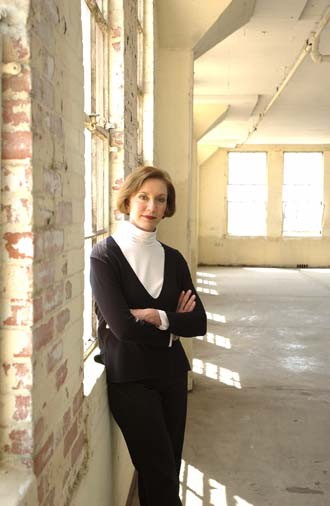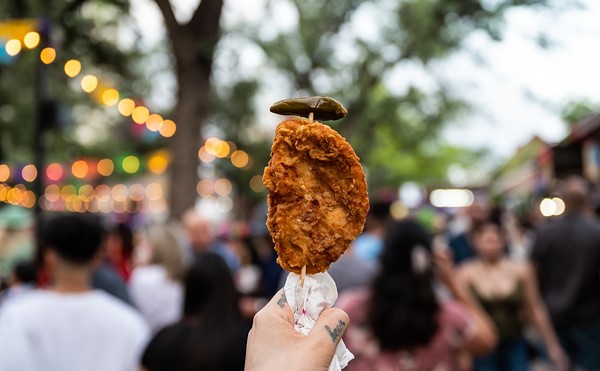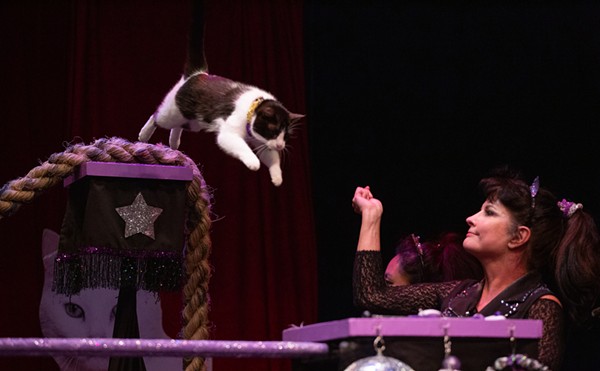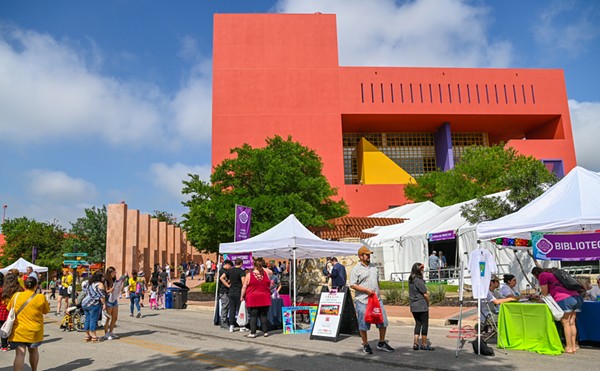They will not be starving artists - or perhaps they will be after moving into CAMPstreet. One of its 20 empty lofts will set a buyer back anywhere from $110,000 to $450,000, in addition to a monthly condo fee as high as $976. Fat cats who pay such tabs could easily end
| Looking up: the CAMPstreet building. Photo by Mark Greenberg |
Pace conceived her latest venture as a memorial to her only son, Chris, who died of a drug overdose in 1997, at age 25. Directly across from CAMPstreet, Teresita Fernández is designing CHRISpark, a sculpture garden that will honor the life of Pace's dead son. "I desperately needed to know that I would be with Chris again - that we would be reunited again in some way that I could not imagine," the still-grieving mother declares in Dreaming Red: Creating ArtPace. Written with San Antonio Express-News columnist Jan Jarboe Russell, the sumptuously designed new book doubles as Pace's autobiography and an illustrated institutional history of the art center she created at 445 North Main, barely more than a pot's throw north of CAMPstreet.
Unlike such venerable retreats as MacDowell (in New Hampshire), Yaddo (in upstate New York), and Bellagio (in northern Italy), where artists are invited to commune with the Muse in magnificent seclusion, ArtPace is an urban space, located downtown in a converted automobile showroom. Since its founding in 1995, ArtPace has provided residencies for more than 80 artists, both local and from places as farflung as Estonia, Brazil, and Australia. Three are chosen at a time - one from Texas, one from elsewhere in the United States, and one from another country. (The three current ArtPace
| "I felt I had an obligation to give back in a significant and extraordinary way. Just living an ordinary life seemed out of the question," Linda Pace states, to explain how she became the Maecenas of artistic provocation, the patron of work that challenges, disturbs, and even offends. Photo by Mark Greenberg |
For the public, ArtPace functions as a gallery, not a museum accumulating a permanent collection, and at the conclusion of each residential cycle, artists vanish with their works. In fact, many of the artists chosen for residencies shun the traditional notion of art as a commodity and the traditional artistic mission of creating collectible objects. During her residency, Philipsz, for example, did not work with paint or clay or stone but rather with sound. She played a recording of herself singing "Banks of the Ohio" from a loudspeaker on the roof of the ArtPace building in order to re-shape the aural ambience of the streets below; a passerby not attuned to contemporary art could call the effort disturbing the peace. That might also be a fair description of the general mission of ArtPace. Fridge's installation includes a black-and-white video of steam and ice crystals filmed inside his freezer.
It is because so many home refrigerators hold jars of hot sauce that Pace can afford to play Maecenas to the global avant-garde. As she recounts in Dreaming Red, whose title derives from its author's somewhat narcissistic fixation on her own nightly dreams, Pace herself is the product of a marriage between business and art - a father who made a fortune in salsa and a mother who made paintings. Her mother, Margaret Bosshardt Pace, also taught drawing at San Antonio College and helped found the Southwest Craft Center. Her father, David Earl Pace, founded a food company that came to dominate the market in picante sauce. Although born in 1945 in North Carolina, where David was stationed in the Air Force, Linda Pace grew up in San Antonio. She studied art at the Southwest Craft Center, Southern Methodist University, University of Texas at Austin, and Trinity University. She and her first husband, Kit
"I felt I had an obligation to give back in a significant and extraordinary way. Just living an ordinary life seemed out of the question," Pace states, to explain how, at the age of 50, when other women of means are reposing in a comfortable complacency, she became the Maecenas of artistic provocation, the patron of work that challenges, disturbs, and even offends. Pace is a paragon of noblesse oblige, a mogul who feels obliged
| DREAMING RED By Linda Pace, Jan Jarboe Russell, Eleanor Heartney ArtPace: A Foundation for Contemporary Art $60, 320 pages ISBN: 1888302003 |
Dreaming Red includes essays by guest curators and panelists, on some of the more notable artists - among them, Xu Bing, Arturo Herrera, Christian Jankowski, Isaac Julien, and Carolee Schneemann - selected for ArtPace residencies over the years. The book's 255 illustrations, 240 of them in color, provide a vivid visual record of what has been happening under the benign auspices of an institution dedicated to process rather than product. Dreaming Red makes it clear that Pace regards her own life as a work-in-progress. CAMPstreet, where she hopes that artists who have passed through ArtPace might be tempted to return to settle, is its latest installation. Its prices are as unsettling as the edgy art for which Pace has been a patron saint.
"Putting San Antonio on the map" has lately been the justification for a golf course, a car factory, and a beauty pageant. It might have been cheaper just to lure Rand McNally from Skokie to a tax-free haven on Camp Street. More than anyone else, Pace has been responsible for giving this city, long a center for velvet Elvises and bluebonnet portraits, international credibility in contemporary art. And yet she chose to launch the publication of Dreaming Red in March with a party at the Dia Center for the Arts in New York, not ArtPace. If San Antonio is still far from the hub of contemporary art, it is, after all the residencies, exhibitions, and colloquia she has sponsored, lucky to be keeping Pace.
ArtPace has done little to eradicate poverty, disease, injustice, or war. Much of its work seems frivolous, expensive toys for privileged grownups. Art itself does not save lives, but at its best it is why life is worth saving. Yet without challenging what we think is best, art is merely furniture. Though she offers lofts at CAMPstreet unfurnished, Pace's largess has provided space for genuine art. For how she has used the bounty of picante sauce to spice up this city, the provisional verdict on Pace's contributions cannot be rotten tomatoes. •



















